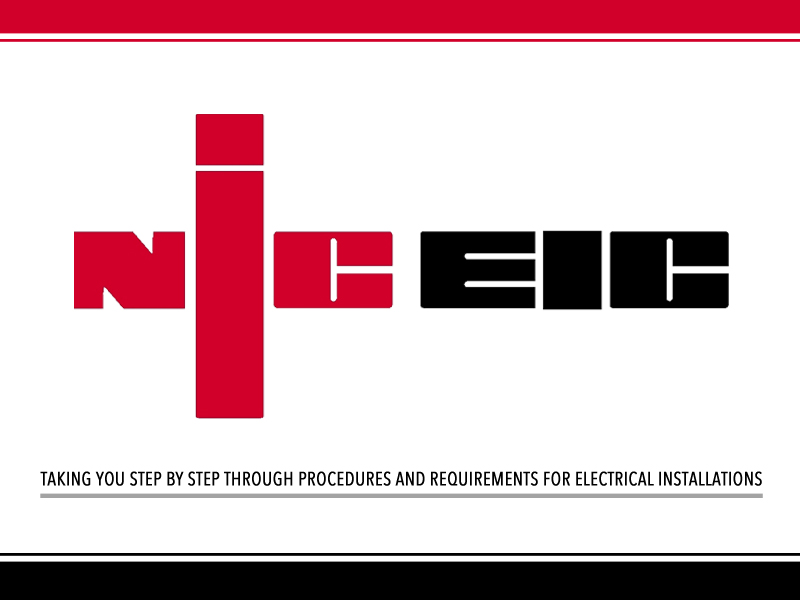
The team at NICEIC remind contractors of the importance of carrying out pre-work checks, when needing to establish the condition of the circuits before removing an existing consumer unit.
Issues can often arise during the replacement of a consumer unit without the condition of the existing circuits having been first assessed. A defect identified after the replacement has been made may prevent a circuit from being re-energised, often leading to conflict with the person ordering the work (client). It is therefore essential that sufficient inspection and testing is carried out before work commences.
General
It is important to establish the condition and functionality of the existing installation prior to undertaking the change or replacement of a consumer unit. For example, lighting controls may be switched to confirm their correct operation and, for socket-outlets, a proprietary ‘plug-in’ socket-tester could be used to check live polarity and confirm the number of socket-outlets connected to each circuit. Wherever possible, any relevant information or documentation regarding previous inspections or issues with the electrical installation should be obtained from the user.
Note: Accessories installed externally, such as an outside light or a socket-outlet, should not be overlooked.
Installation earthing
The installation should be reliably connected to a suitable means of earthing (Regulation 542.3.2). An external earth fault loop impedance (Ze) test, as shown in Fig 1, should be undertaken to confirm the adequacy of the installation earthing and that the obtained value is appropriate for the type of earthing arrangement. For the purposes of the test, the installation should be isolated from the supply and the earthing conductor disconnected.
Note: All main earthing and bonding conductors disconnected for the test must be reconnected before the installation is re-energised.
If the measured value of Ze is higher than that expected for a TN arrangement, this wouldn not necessarily prevent the consumer unit replacement as long as the relevant disconnection requirements of Chapter 41 of BS 7671 are met for all circuits reconnected (Regulation 411.3.2.2).
For final circuits protected by an 30 mA RCD, this higher value of external impedance should not compromise the rapid operation of such devices under fault conditions.
Maximum values of Zs for RCDs to BS EN 61008-1 and BS EN 61009-1 are given in Table 41.5 of BS 7671. However, for circuits not protected by an RCD, such as a distribution circuit, an earth fault loop impedance test should be conducted to confirm the relevant disconnection time will be achieved (Regulation 411.3.2.3 refers).
For an installation forming part of a TT system the requirements of Regulation 411.5.3 must be satisfied; that is, where an RCD is used for fault protection the disconnection time shall be that required by Regulations 411.3.2.2 or 411.3.2.4 and RA x IΔn ≤ 50 V. Additionally, these conditions are deemed to be met where the earth fault loop impedance (Zs) meets the requirements of Table 41.5.
Note: Where a higher than expected external impedance is measured the client should be advised to inform the Distribution Network Operator (DNO).
Protective bonding conductors and circuit protective conductors (cpcs)
The adequacy of the earthing and bonding arrangements should always be confirmed before any additions or alterations are made (Regulation 132.16 refers).
The ‘wander lead’ test method is typically used to confirm the presence of all circuit protective conductors. As illustrated in Fig 2, the test is performed with the consumer unit isolated and the main protective bonding conductors temporarily disconnected. One lead of the continuity test instrument is connected to the MET and the other test probe is connected, using a wander lead, to all relevant points, such as the earth terminals at ceiling roses or socket-outlets and the metallic fixing screws at switches.
Once the circuits have been connected to the new consumer unit, continuity of protective conductors should be re-confirmed and the readings obtained for each circuit should be recorded in the R2 column of the test schedule forming part of the EIC or DEIC.
Note: For some accessories the fixing screw may not provide a connection to earth, so to perform the test the circuit should be isolated before removing the accessory cover.
Ring final circuits
In addition to the ‘live’ polarity checks at socket-outlets described earlier, the continuity of the loop conductors should be verified to identify any high resistance or a break in continuity. To minimise any risks during the test, the whole consumer unit, rather than individual protective devices, should be isolated before disconnecting conductors.
It may be preferable to split the ring and perform the test at a socket-outlet rather than the consumer unit. Where a break in continuity or other issues are identified, such as underneath the floorboards, the remedial work involved could be significant, therefore the client should be made aware of the issue immediately.
Lighting circuits
Lighting circuits in an older installation may not incorporate a cpc. Where this is the case, the client should be advised to have a cpc installed. If the client is not willing to have the work carried out, then they should be informed that reconnection of the lighting circuit is permitted only on condition that any metallic (Class I) light fittings and accessories are replaced with all insulated or Class II types.
A label should be affixed to the consumer unit stating that Class I equipment must not be connected to the lighting circuit. Details of the unearthed circuit should be recorded on the Electrical Installation Certificate (EIC or DEIC).
Another common issue relating to lighting circuits is the possibility of a shared ‘borrowed’ neutral conductor. The neutral conductors of each circuit must be electrically separate to prevent circuits being energised inadvertently (Regulation 521.8.2 refers).
Verifying that the neutral conductors are separate throughout the installation is achieved using an insulation resistance test instrument (refer to ‘Insulation resistance testing’).
Note: Where a shared neutral is identified, the circuit should not be re-connected. The client should be advised to have the necessary remedial work carried out before replacing the existing consumer unit.
Insulation resistance testing
If a low insulation resistance reading is obtained, this may be due to damage, the age of the cables, bad/loose connections or corrosion to connected equipment. However, once reconnected to the new consumer unit such pre-existing defects may cause the operation of RCDs. For these reasons, insulation resistance testing should be carried out on all reconnected circuits.
Insulation resistance testing should preferably be carried out at 500 V DC between live conductors to Earth (with protective conductor(s) connected to the earthing arrangement). However, where there is a risk of damage to connected equipment the applied test voltage may be reduced to 250 V DC. Irrespective of which test voltage is applied, a value less than 1 MΩ should be investigated.
Location of the consumer unit
The exact location of the replacement consumer unit and any necessary works should be carefully assessed and agreed with the client prior to its replacement. For example, it may be necessary for the replacement unit to be installed in a more accessible position to facilitate its operation (Regulation 132.12 refers).
However, the additional work involved in extending the circuits and routing them to the new position, even over a short distance, could be significant. For example, increasing the length of the meter tails is likely to require a separate device to be installed to satisfy the requirements for overcurrent protection.
Note: Although the height of the original consumer unit may not have complied with Approved Document M for England (similar requirements apply in other parts of the UK), any replacement will provide the opportunity to resolve such an issue.
Certification
An EIC or DEIC should be issued to the client on completion (Regulation 644.1). To ensure the person issuing the certificate is only accepting responsibility for the work undertaken (the replacement of the consumer unit and the safety of the circuits connected to it) the description of work should be recorded accurately and a tick should be inserted in the appropriate box on the certificate to indicate that the work involves the replacement of a consumer unit. The replacement of a consumer unit in a dwelling in England and Wales is notifiable work and must be certificated for compliance with Part P of the Building Regulations.
Summary
Some contractors have found that they’re unable to re-energise a particular circuit after replacing a consumer unit because of an existing defect.
Whilst, for an existing installation it is impracticable to carry out all the tests that are required for initial verification, the level of inspection and testing undertaken for each circuit should be sufficient to confirm
hat it is safe to re-energise. Any defect that affects the safety of the work carried out should be corrected before the EIC or DEIC is issued (Regulation 644.1.2).
For further guidance on the replacement of a consumer unit refer to the Electrical Safety First Best Practice Guide 1: Replacing a consumer unit in domestic premises, which is available to download free of charge.
Download the ESF Best Practice Guide by clicking here
Get more details about NICEIC registration by clicking here











